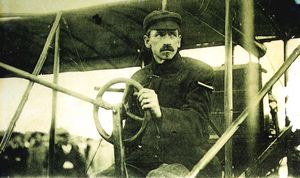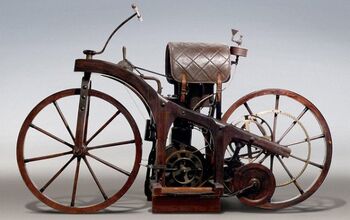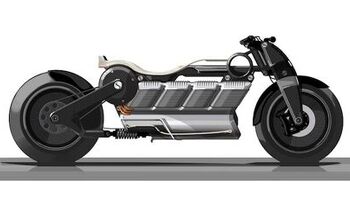1907 Curtiss V-8
"The Fastest Man in the World"
Wearing a leather cap, a well-manicured moustache and a steely gaze Glenn Hammond Curtiss stares out of a time-worn black and white postcard-like photo. In the background frothy waves plash upon a beach, the very hard packed sands upon which his experimental V-8 powered motorcycle would transport him into the history books as "The Fastest Man in the World." The day was Thursday January 24, the year 1907; the place, Ormond Beach on the east coast of Florida. The record... 136.3 mph, an absoloute land speed record that would stand for eleven years and then only be surpassed by an automobile. The year would be 1930, before another motorcycle would best Glenn Curtiss's 1907 feat of daring-do and mechanical design.
The surfside setting for the famous blast down the beach had its origins a few years earlier, when in 1902, influential Ormond Beach residents began promoting racing on the local beach with an inaugural automobile speed run. The sport grew in popularity and even Henry Ford showed up for an event in one of his early cars. Henry slept in his car, since at the time he couldn't afford the hotel room. Another "celebrity" who could afford just about anything took up residence in Ormond Beach, none other than John D. Rockefeller, who had decided to live to 100 and was looking for the perfect healthy environment in order to reach the century mark (he made it to 97). Ormond Beach became a playground for the rich and famous... and those feeling the need for speed. Case in point, one Glenn H. Curtiss, a true American hero and a larger than life personality who's exploits would even inspire a popular series of youth books "The Adventures of Tom Swift" penned by Victor Appleton. And yes, there was one volume circa 1910 titled "Tom Swift and His Motor-Cycle" or "Fun and Adventures on the Road."
Curtiss was always looking for new adventures on, or off, the road.
A Man of Many Firsts: Taking a fork in the road that would transport him from the beaches of Florida to the clouds above, Curtiss by 1910 would relinquish his interest in motorcycles. Although Curtiss produced motorcycles under the name Marvel until 1914 he would chart a new course into the pages of aviation history. This would include earning the first pilot license in 1910, being the first to fly a kilometer, produce the first plane to cross the Atlantic Ocean, the first to carry a passenger in a seaplane, and the first to train the first American female pilot Blanche Stuart Scott. His talents would lead to the development retractable wheels and thus the first amphibious aircraft. Add to the list the designing of dirigibles for the U.S. Army and the manufacture and sale of the first private airplanes. The Curtiss Aeroplane and Motor Company became the largest aircraft manufacturer in the world with over 20,000 employees. To the list of Glenn Curtiss milestones, add no les than the invention of the aircraft carrier. In addition to building motorcycles and airplanes, Glenn Curtiss built cities. During 1919-26 he developed Hialeah, Miami Springs and Opa-Locka, Florida. And to visit them, in his spare time, he tinkered up the streamlined travel trailer.
Back in 1907, the 29-year old Glenn Curtiss had already invented or developed many of the more than 500 designs and components he would conjure up during his lifetime. These included a hand in the development of the first Wright Brothers airplane and additional aeronautical experiments in partnership with Alexander Graham Bell, including the development and patenting of the aircraft aileron, which is now universally intrinsic to controlled flight.
To the list of Glenn Curtiss milestones, add no les than the invention of the aircraft carrier. In addition to building motorcycles and airplanes, Glenn Curtiss built cities.
Whether it was propeller powered or rolled on wheels, Glenn was always pushing the envelope. While his lasting fame would rest with aircraft, it all began with motorcycles. As a result of his experience as a bicycle racer, Western Union bicycle messenger and bicycle shop owner Curtis became interested in motorcycles. In 1901, he began motorizing bicycles with his own single cylinder internal combustion engines, initially fashioned from tomato cans. He not only talked the talk, he walked the walk, racing what he built and earning the accolade in 1903 as the "First American Motorcycle Champion" by reaching 54.6 mph. By 1905, he set the world speed records for one, two and three mile events. Besides piloting his speedsters, he tinkered out a number of advancements including the handlebar twistgrip throttle control and a triple cylinder engine designated the W-3, essentially a V-twin with a third cylinder which Curtiss himself called the fastest production motorcycle in the world.
How such ingenuity arose, is one of those mysteries of nature, for Curtiss was raised in near poverty and lost his parents when very young and subsequently only attained an 8th grade education. As Trafford Doherty, Director of the Curtiss Museum explains, "Curtiss was incredibly intuitive and incredibly mechanical. He was also extremely athletic and in the 1890s was virtually unbeaten as a bicycle racer. He was very competitive and that competitive nature appeared first in bicycles, then motorcycles and then in his business ventures. While of a serious demeanor, a man of relatively few words and not comfortable with public speaking, he was also known to be congenial among his fellows. His contributions were legion and rightly earned him the accolades as "The Henry Ford of Aviation" and "The Fastest Man in the World."
...it would be his lightweight air-cooled V-8 that would literally make his mark.
It would be a cool and overcast day in 1907, that Glenn Curtis would make his mark (in the history books of motorcycling at least). He had been designing and building a variety of engines, including singles, V-twins and inline fours. However, it would be his lightweight air-cooled V-8 that would literally make his mark. The power plant came into existence, due to the ever-increasing demand for more powerful aircraft engines for the burgeoning production of early 20th century flying machines. The record-breaking motorcycle itself was basically a rolling, but not quite flying, test bed for the new Curtiss 40hp "monster" motor.
The configuration was based on a very square 3.25 x 3.25 inch bore and stroke that displaced a potent 269 cubic inches. While his preceding engines were primarily single cylinder and 50-degree V-Twins, Curtis went to a 90 degree design featuring cast iron F-type heads as utilized on his smaller
Taking the full two miles to reach top speed, Curtis was clocked at 136.3 mph in the timed section of the course.Once the machine was unloaded at Ormond Beach, Glenn Curtiss surveyed the salt- sprayed four-mile course. It was divided into a two-mile section for reaching top speed, a third mile for timing purposes, and last by not least a "slow down and stop" mile. As the bike was shaft-driven with no clutch and but one tall gear, it was an all or nothing proposition. One kept twisting the throttle and let the speed build, while the screaming unmuffled pipes scattered sea birds for miles. As the Curtiss Museum director comments, "It must have sounded like the Wrath of God!"
Assisting Curtis were Thomas Baldwin and the aptly named "Tank" Waters, their brawn was used to push-start the machine into life. They needed to be hale and hearty fellows, and stout they were, since the bump-start method often required as many as ten or more attempts to get the V-8 burbling and barking.
The Name Game: The "H." in Glenn H. Curtiss stands for Hammond, the middle name derived from his birthplace Hammondsport, New York, its name in turn derived from the town's founder. Because it was located on Lake Keuka, it also became the focal point for U.S. Navy aviation, earning Curtiss yet another accolade as "The Father of Naval Aviation", since he sold the first "aeroplane" to the Navy in 1911. Inventors, designers and fliers from around the globe converged on Hammondsport drawn by the common desire to design and manufacture flying machines, flying boats, and dirigibles. As such, the area became a World War I arsenal engaged in the production of the legendary Curtiss "Jenny" trainer in which thousands of U.S. and Canadian pilots earned their wings. Another generation later and the Second World War brought renewed aircraft building activity to the area, during which time the Mercury Aircraft Co. manufactured tail assemblies for the Curtiss P-40 War Hawk aircraft, known variously as the "Tomahawk", "Kitty Hawk", and "Flying Tiger."
Skilled and cool-headed rider that he was, Curtis was able to bring the shuddering beast to a halt, from 90mph, when parts began flailing about.
Curtiss climbed into the saddle, positioned his goggles and gripped the handlebars, perhaps glancing down once more at the Goodrich tires biting into the beach sand and nodded. Fortunately, it was not the horrendously humid Florida summer months, and the two men hurled Curtiss and his V-8 two-wheeler down the beach and into the history books. Taking the full two miles to reach top speed, Curtis was clocked at 136.3 mph in the timed section of the course. He would be the first man to travel one mile in 26 2/5 seconds, a feat of mechanical design and personal courage that earned him the title "The Fastest Man on Earth". Ironically, the record was considered "unofficial" due to a potentially fatal mechanical problem that precluded it from running the course again under official observation. In other words, the bike broke-down, after only one complete run through the course. Skilled and cool-headed rider that he was, Curtis was able to bring the shuddering beast to a halt, from 90mph, when parts began flailing about.
The event was reported in the February 9, 1907 issue of Scientific American (and we quote): "THE FASTEST AND MOST POWERFUL AMERICAN MOTOR BICYCLE. What is unquestionably the most powerful as well as the fastest motor bicycle ever built in this country made its appearance at the races at Ormond Beach recently; but, owing to the breaking of a universal joint and subsequent buckling of the frame, this machine made no official record. It was built by Mr. G. H. Curtiss, a well-known motor-bicycle maker, with the idea of breaking all records. The machine was fitted with an 8-cylinder air-cooled V-motor of 36-40 horse-power... The total weight of the complete machine was but 275 pounds, or 6.8 pounds per horse-power. In an unofficial mile test, timed by stop watches from the start by several persons who watched through field glasses a flag waved at the finish, Mr. Curtiss is said to have covered this distance in 26 2/5 seconds, which would be at the rate of 136.3 miles per hour - a faster speed than has ever been made before by a man on any type of vehicle. Unfortunately, before this new mile record could be corroborated by an official test, the universal joint broke while the machine was going 90 miles an hour..."
If you want to see the real McCoy you'll find it at the new Smithsonian Steven F. Udvar-Hazy Center.
In addition, armchair pundits of the day reportedly snorted with disbelief espousing their firm belief that is was a hoax or fable since no mortal man could breathe at the reported speed. It would be the V-8's one and only day in the sun, the only time Glenn Curtiss would take it up to speed. But once was enough.
As for his vaunted V-8 motorcycle, a bolt for bolt replica of the ferocious machine was built by the Mercury Aircraft Co. and is now on display at the Curtiss Museum. If you want to see the real McCoy you'll find it at the new Smithsonian Steven F. Udvar-Hazy Center located adjacent to the Dulles International Airport in Chantilly, VA (www.nasm.si.ed.u). As a poignant postscript, we are told by the Curtiss Museum that several of the engine's internal parts were recycled by Curtiss into other projects, so in a way it lives on as does the almost legendary achievements of Glenn H. Curtis.
Curtis Museum: Located on Lake Keuka in Hammondsport, New York, the museum's 57,000 sq. ft. features the full spectrum of Glenn Curtiss's contributions. On display are his many aircraft designs as well as his bicycles and motorcycles including a faithful reproduction of the record breaking V-8. For more information call (607) 569-2160 or contact the Museum Director Trafford Doherty.
More by Paul Garson
































Comments
Join the conversation